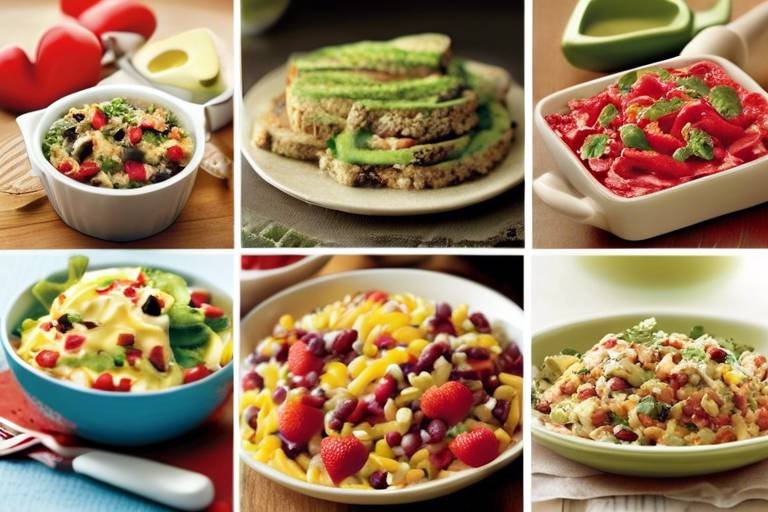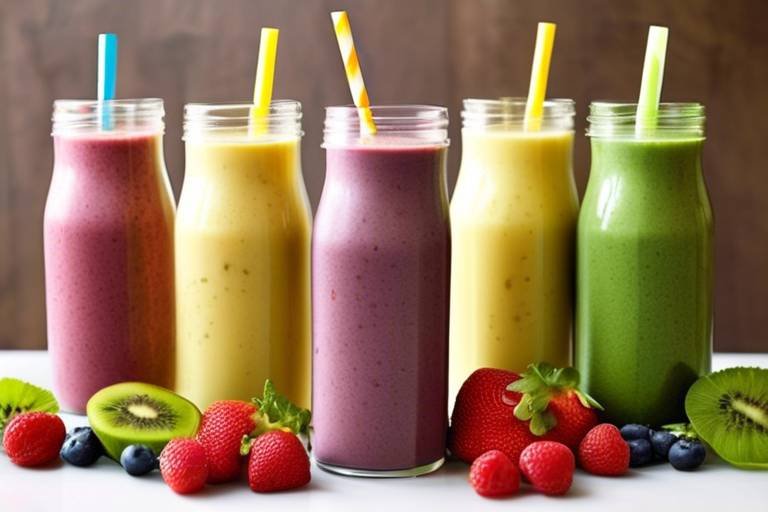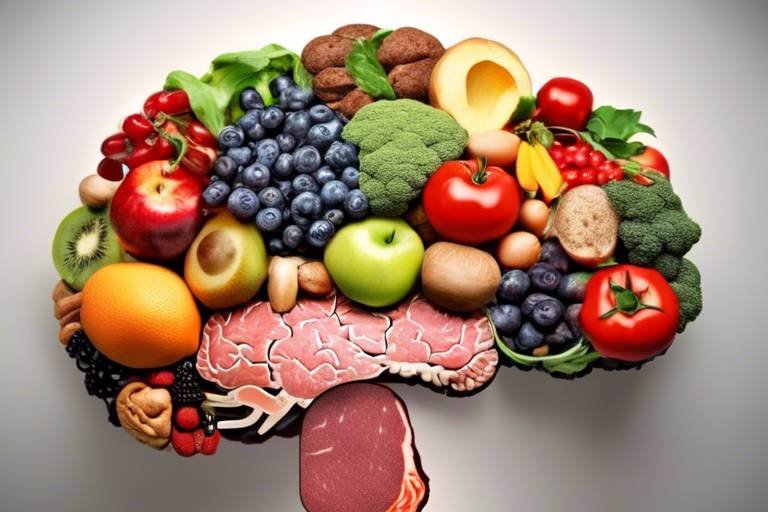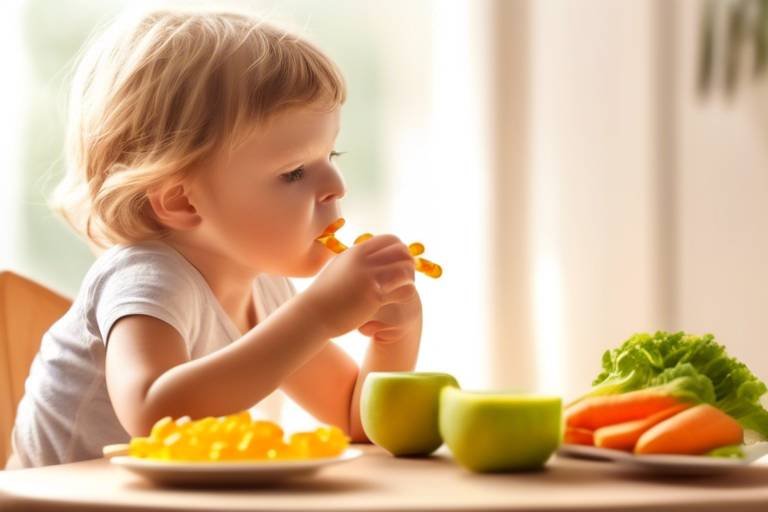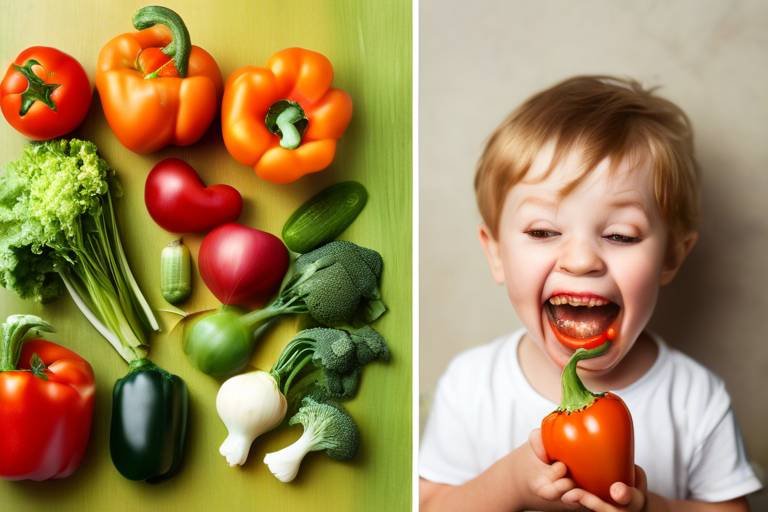Prepping Healthy After-School Snacks Your Kids Will Love
As the school bell rings and your little ones rush through the door, their energy levels might be on a rollercoaster ride. After a long day of learning, they need a boost, and what better way to refuel than with healthy snacks? Prepping nutritious after-school snacks can be a game changer, not only for their energy but also for their overall well-being. Imagine your kids diving into a plate of colorful, tasty treats that not only satisfy their hunger but also nourish their growing bodies. Sounds delightful, right?
In this guide, we’re going to explore a treasure trove of creative and nutritious snack ideas that your kids will absolutely love. From vibrant fruit kabobs to crunchy veggie dips, we’ll cover everything you need to make healthy snacking fun and appealing. Plus, we’ll share tips on involving your kids in the preparation process, making them more likely to enjoy what they eat. So, let’s dive in and discover how to turn snack time into a delicious and healthy adventure!
Understanding the importance of healthy snacks can help parents make better choices. Think of snacks as the fuel that powers your child's body and mind. Nutrient-rich snacks support children's growth, energy levels, and concentration after a long school day. When kids munch on wholesome foods, they’re not just filling their tummies; they’re also enhancing their ability to focus on homework and activities. It’s like giving their brains a little turbo boost!
Now that we know why healthy snacks are crucial, let’s explore some simple and quick snack ideas that require minimal preparation. These snacks are not only healthy but also delicious, ensuring your kids look forward to them every day. You don’t have to spend hours in the kitchen; sometimes, the simplest ideas are the most effective. For instance, consider incorporating fresh fruits and vegetables into snacks. Not only do they provide essential vitamins and minerals, but they also offer colorful, crunchy options that kids find fun to eat.
When it comes to fruits and veggies, the more colorful, the better! Kids are naturally drawn to bright colors, and incorporating these into their snacks can make healthy eating feel like a fun game. For example, fruit kabobs are a playful way to serve fruits. Kids can help assemble them, making healthy eating an interactive experience that encourages creativity and choice. Just grab some skewers and let them pick their favorite fruits!
Fruit kabobs are not just a treat; they’re a canvas for creativity! You can use a variety of fruits such as strawberries, bananas, grapes, and melon. The best part is, kids can choose their combinations, making them more likely to eat what they’ve created.
Pairing veggies with healthy dips can make them more appealing. Options like hummus or yogurt-based dips add flavor and excitement to snacking while promoting healthy habits. Kids can dip carrot sticks, cucumber slices, or bell pepper strips into their favorite dips, turning a simple snack into a fun activity.
Whole grains are another fantastic option for after-school snacks. They are an excellent source of fiber and energy, keeping kids full and satisfied between meals. Think whole grain crackers with cheese, or popcorn tossed with a sprinkle of nutritional yeast for a cheesy flavor without the guilt. Introducing whole grain snacks can help keep kids energized and focused on their homework.
Getting kids involved in preparing their snacks can increase their interest in healthy eating. When they take part in the process, they feel a sense of ownership over what they eat. Simple tasks, like washing fruits and vegetables or assembling their snacks, can empower children and encourage them to try new foods. Plus, it’s a great way to bond with your kids!
Let’s explore some kid-friendly recipes designed for children to make themselves or with minimal assistance. These recipes not only promote independence but also instill healthy eating habits from a young age. For instance, a simple yogurt parfait with layers of yogurt, granola, and fresh fruit can be a delightful treat that kids can customize to their taste.
The way snacks are presented can influence a child's willingness to try them. Creative plating and fun shapes can make healthy snacks more enticing and enjoyable. Use cookie cutters to create fun shapes out of fruits or sandwiches. A little creativity goes a long way in making healthy eating a delightful experience!
If time is limited, there are many healthy store-bought snack options available. Learning to choose the right products can help parents provide nutritious snacks without the hassle of preparation. Look for snacks that are low in added sugars and high in fiber.
Understanding how to read nutrition labels is crucial for making informed choices. Parents can learn to identify healthy snacks by looking for key ingredients and nutritional values. Aim for snacks with whole ingredients and minimal processing. It’s like being a detective in the grocery store, searching for the best options for your family!
Finding snacks that cater to food allergies is essential for many families. Knowing which brands and products are safe can help ensure all kids can enjoy their snacks without worry. Always check labels for common allergens and consider reaching out to brands for more information if needed.
Q: What are some quick healthy snack ideas for after school?
A: Some quick ideas include fruit kabobs, yogurt with granola, veggie sticks with hummus, and whole grain crackers with cheese.
Q: How can I get my kids to eat more vegetables?
A: Involve them in the preparation process, offer fun dips, and present the veggies in creative ways to make them more appealing.
Q: What should I look for in store-bought snacks?
A: Look for snacks with whole ingredients, low added sugars, and high fiber content. Always read the nutrition labels!

Why Healthy Snacks Matter
Understanding the importance of healthy snacks can significantly impact your child's well-being. After a long day of learning and socializing at school, children often come home feeling tired and hungry. This is where the right snacks can make a world of difference. Instead of reaching for sugary treats or processed foods, opting for nutrient-rich snacks can support their growth, boost their energy levels, and enhance their concentration. Think of healthy snacks as fuel for their bodies and brains, helping them transition smoothly from the classroom to home.
Research shows that children who consume balanced snacks tend to perform better academically and exhibit improved behavior. When you provide your kids with wholesome options, you're not just satisfying their hunger; you're also laying the foundation for lifelong healthy eating habits. Snacks packed with vitamins, minerals, and fiber can help regulate their mood and energy, keeping them engaged and active in their after-school activities.
So, what exactly should parents look for in healthy snacks? Here are some key factors to consider:
- Nutritional Value: Aim for snacks that provide essential nutrients like protein, fiber, and healthy fats.
- Natural Ingredients: Choose snacks with minimal processing and ingredients you can recognize.
- Portion Control: Keep serving sizes appropriate to avoid overeating.
Incorporating a variety of flavors and textures is also crucial. Kids are more likely to enjoy snacks that are visually appealing and fun to eat. By introducing colorful fruits, crunchy vegetables, and whole grains, you can create a balanced snack that satisfies their taste buds and nutritional needs. Remember, healthy snacking is not just about what they eat, but also how it makes them feel!
Ultimately, making healthy snack choices can lead to a more focused, energetic, and happy child. As parents, it’s our responsibility to guide them towards making better food choices, and it all starts with the snacks we offer. By prioritizing healthy options, we can set our children up for a lifetime of wellness and vitality.

Easy Snack Ideas
When it comes to after-school snacks, the key is to keep things simple yet exciting. Kids are often tired and hungry after a long day at school, so providing them with quick and nutritious options can make all the difference. Imagine a world where your kids race home, not just to dump their backpacks but to dive into healthy snacks that taste amazing! With a little creativity and some pantry staples, you can whip up snacks that are both delicious and nutritious without breaking a sweat.
One fantastic approach is to focus on fruits and vegetables. These colorful foods are not only packed with vitamins and minerals but also provide a fun and crunchy texture that kids love. Think about it: a vibrant plate of sliced bell peppers, carrots, and cucumbers can be a visual feast that kids can't resist. Pair them with a tasty dip, and you have a snack that’s both healthy and satisfying. For instance, a simple yogurt-based dip or creamy hummus can elevate the experience, turning ordinary veggies into a fun afternoon treat.
One of the most playful ways to serve fruits is through fruit kabobs. These skewers allow kids to pick and choose their favorite fruits—think strawberries, grapes, and melon chunks—while adding an element of fun to snack time. Not only is this a great way to encourage them to eat more fruits, but it also gives them a sense of ownership in their food choices. You can even let them create their own patterns or designs, making it a fun activity that promotes healthy eating!
Next up on our snack list are veggie dips. Sometimes, all it takes to make veggies appealing is a delicious dip. Kids love to dunk their food, and when you provide them with options like hummus, guacamole, or a yogurt-based ranch dip, they might just forget they’re eating something healthy! This not only makes the veggies more enticing but also introduces them to a variety of flavors and textures. You can even set up a mini "dip bar" with different veggies and dips, allowing them to experiment and discover their favorites.
For those days when you're short on time, consider incorporating whole grain options into your snacks. Whole grains are an excellent source of fiber and energy, helping to keep your kids full and satisfied between meals. Think whole grain crackers, popcorn, or even whole grain toast topped with nut butter and banana slices. These options are not just healthy; they also offer a satisfying crunch that kids love. Plus, when you present them in fun shapes or with creative toppings, you’re sure to grab their attention!
In conclusion, the world of easy snack ideas is bursting with possibilities. By focusing on fruits, veggies, and whole grains, you can ensure that your kids have access to snacks that are not only healthy but also enjoyable. Remember, the goal is to make snacking an adventurous experience, one that your kids will look forward to every day!
Q: How can I encourage my kids to try new snacks?
A: Involve them in the snack preparation process! Let them choose ingredients or help assemble snacks. Making it a fun activity can spark their interest in trying new foods.
Q: What if my child has food allergies?
A: Always read labels and opt for allergy-friendly brands. There are plenty of nutritious snack options available that cater to various dietary restrictions.
Q: How can I make healthy snacks more appealing?
A: Presentation is key! Use fun shapes, colorful plates, and creative arrangements to make healthy snacks visually appealing.

Fruits and Vegetables
When it comes to snacking, are like nature's candy—sweet, crunchy, and packed with essential nutrients. Imagine a vibrant rainbow of colors on your kitchen counter, each fruit and vegetable offering a unique taste and a plethora of health benefits. Incorporating these fresh options into your kids' after-school snacks not only promotes healthy eating habits but also provides the vitamins and minerals crucial for their growth and development.
One of the best ways to make fruits and veggies appealing to children is by presenting them in fun and engaging ways. For instance, consider creating a colorful platter that features an array of fruits and vegetables. You can include:
- Strawberries - juicy and sweet, perfect for a quick energy boost.
- Carrot sticks - crunchy and satisfying, great for dipping.
- Apple slices - crisp and refreshing, especially when paired with peanut butter.
- Cucumber rounds - cool and hydrating, ideal for hot days.
- Bell pepper strips - colorful and crunchy, offering a sweet flavor.
Another fantastic idea is to create fruit kabobs. These are not just a snack; they are an adventure! Kids can help assemble their kabobs, choosing their favorite fruits and arranging them on skewers. This interactive experience not only encourages them to eat healthier but also fosters creativity. You can mix and match fruits like grapes, melon, pineapple, and kiwi to create a visually stunning snack that’s as delightful to look at as it is to eat.
Don’t forget about the power of veggie dips. Pairing fresh veggies with tasty dips can transform them from a simple snack into a delicious treat. Hummus is a fantastic option, offering a creamy texture and a nutty flavor that kids often love. You can also try yogurt-based dips, which can be flavored with herbs or spices to add some zing. The dip not only enhances the flavor but also makes the veggies more appealing to those picky eaters.
Incorporating fruits and vegetables into your kids' snacks is a win-win situation. Not only are they delicious, but they also provide a healthy alternative to sugary snacks. So, the next time you’re looking for snack ideas, think of the colorful, crunchy world of fruits and veggies. They’re not just good for you; they’re also a lot of fun!

Fruit Kabobs
Fruit kabobs are not just a snack; they’re a delightful experience that transforms ordinary fruits into a fun culinary adventure! Imagine vibrant, colorful pieces of fruit skewered on a stick, creating a rainbow of flavors that your kids will be eager to munch on after a long day at school. The beauty of fruit kabobs lies in their simplicity and the creativity they inspire. You can mix and match various fruits, allowing your children to choose their favorites, which makes them feel involved in the process.
To whip up these fruity delights, all you need are some skewers and a selection of fresh fruits. Think juicy strawberries, sweet pineapple chunks, crisp apple slices, and refreshing grapes. Not only do these kabobs look appealing, but they also pack a punch of essential vitamins and minerals that are crucial for your kids’ growth and development. Plus, they’re a fantastic way to sneak in some extra servings of fruit into their diets!
Here’s a simple way to get started with fruit kabobs:
- Gather your ingredients: Choose a variety of colorful fruits. The more colors, the better!
- Prep the fruits: Wash and cut them into bite-sized pieces. Make sure the pieces are small enough for little hands to handle.
- Skewer the fruits: Let your kids get creative! They can alternate between different fruits, creating patterns or just throwing them on randomly. This not only makes it fun but also encourages them to eat a variety of fruits.
For an added twist, consider serving the kabobs with a yogurt dip or a drizzle of honey. This not only enhances the flavor but also adds a creamy texture that kids love. You can even sprinkle some granola on top for a crunchy element that makes the kabobs even more exciting! The key here is to make the experience interactive and enjoyable, allowing your kids to take ownership of their snacks.
Fruit kabobs are also perfect for playdates or after-school gatherings. They can be a hit at birthday parties or family picnics, offering a healthy alternative to sugary snacks. Plus, they’re easy to transport and can be made ahead of time, so you can focus on enjoying the moment with your kids instead of worrying about snacks!
In summary, fruit kabobs are a fantastic way to promote healthy eating habits while making snack time a fun and engaging experience. The next time your kids come home from school, surprise them with these colorful, tasty treats, and watch as they dive into a world of fruity goodness!

Veggie Dips
Veggie dips are a fantastic way to make healthy eating exciting for kids. Imagine a colorful platter of fresh vegetables, each one waiting to be dunked into a creamy, flavorful dip. Not only do these dips enhance the taste of vegetables, but they also provide an opportunity for kids to experiment with different flavors and textures. It's like turning snack time into a mini culinary adventure!
One of the best things about veggie dips is their versatility. You can whip up a variety of dips using simple ingredients that you likely already have in your pantry. For instance, hummus, made from chickpeas, tahini, and olive oil, is a crowd-pleaser that’s packed with protein. Alternatively, a yogurt-based dip can be a refreshing option, especially when flavored with herbs like dill or spices like garlic powder. These dips not only taste great but also add a nutritional punch to your child's snacking routine.
To make veggie dips even more appealing, consider involving your kids in the preparation process. They can help wash and cut the vegetables (with supervision, of course) and mix the dips. This engagement can spark their interest in healthy foods and give them a sense of ownership over their snacks. Plus, when kids create their own snacks, they’re more likely to eat them!
Here are a few dip ideas that are sure to please:
- Classic Hummus: Blend chickpeas, tahini, lemon juice, garlic, and olive oil for a smooth, creamy dip.
- Ranch Yogurt Dip: Mix plain yogurt with ranch seasoning for a tangy, kid-friendly option.
- Guacamole: Mash ripe avocados with lime juice, salt, and diced tomatoes for a zesty dip that pairs perfectly with crunchy veggies.
Don’t forget about presentation! Create a vibrant veggie platter with a rainbow of colors. Think bright carrots, crisp cucumbers, sweet bell peppers, and cherry tomatoes. Arrange them in a way that makes the platter inviting and fun. You can even use cookie cutters to shape the veggies into stars or hearts, adding an element of surprise that will have your kids excited to dive in.
Ultimately, veggie dips can transform snack time from a mundane routine into a delightful experience. By making healthy eating fun and interactive, you’re not just filling their bellies; you’re fostering a lifelong appreciation for nutritious foods that can benefit their growth and development.
Q: What vegetables are best for dipping?
A: Crunchy vegetables like carrots, celery, bell peppers, and cucumber are excellent choices. They provide a satisfying crunch that pairs well with dips!
Q: How can I make dips healthier?
A: Use low-fat yogurt or substitute sour cream with Greek yogurt. You can also add herbs and spices for flavor without extra calories.
Q: Can I prepare veggie dips in advance?
A: Absolutely! Most dips can be made a day ahead and stored in the refrigerator. Just make sure to keep them in airtight containers to maintain freshness.

Whole Grain Options
When it comes to snacking, whole grains are a fantastic choice for keeping your kids satisfied and energized. These nutritious powerhouses are packed with fiber, which is essential for digestion and helps maintain steady energy levels throughout the day. Think of whole grains as the sturdy foundation of a house; they provide stability and support, ensuring your kids have the fuel they need to tackle homework, sports, and playtime after school.
One of the best things about whole grains is their versatility. You can incorporate them into a variety of snacks that are not only healthy but also delicious. For instance, consider whole grain crackers paired with cheese or nut butter. This combination not only satisfies hunger but also provides a great balance of protein and healthy fats. Additionally, you can whip up some homemade popcorn using whole grain kernels. It’s a fun snack that kids can help prepare, and you can make it even more exciting by adding a sprinkle of their favorite seasonings.
Another excellent whole grain option is oatmeal. It’s not just for breakfast! You can transform oatmeal into a delightful snack by creating oatmeal energy balls. Simply mix rolled oats with honey, nut butter, and a few chocolate chips or dried fruits, roll them into bite-sized balls, and refrigerate. These little bites of goodness are perfect for a quick energy boost and are easy for kids to grab on their way to their next adventure.
To make it easier for parents to choose whole grain snacks, here's a quick comparison table that highlights some popular options:
| Snack | Whole Grain Option | Benefits |
|---|---|---|
| Crackers | Whole Grain Crackers | High in fiber, great for pairing with dips or cheese |
| Popcorn | Air-Popped Popcorn | Low in calories, high in fiber, fun to eat |
| Granola Bars | Homemade Whole Grain Granola Bars | Customizable, packed with nutrients, and no preservatives |
| Rice Cakes | Whole Grain Rice Cakes | Light and crunchy, perfect for toppings |
By incorporating these whole grain snacks into your kids’ after-school routine, you’re not just filling their tummies; you’re also instilling healthy habits that can last a lifetime. Remember, kids are more likely to enjoy their snacks when they see you excited about them too! So, get creative, have some fun, and watch as your children develop a love for healthy eating.
Q: What are some easy whole grain snacks I can prepare?
A: Some easy options include whole grain crackers with cheese, air-popped popcorn, and homemade oatmeal energy balls. These snacks are simple to prepare and can be customized to your child's taste preferences.
Q: How can I tell if a snack is truly whole grain?
A: Look for the word "whole" in the ingredient list, such as "whole wheat" or "whole oats." Additionally, check the nutrition label for fiber content; snacks with at least 3 grams of fiber per serving are typically good choices.
Q: Are whole grain snacks suitable for kids with gluten allergies?
A: Yes, there are many gluten-free whole grain options available, such as brown rice cakes, quinoa snacks, and gluten-free oats. Always check the packaging to ensure they are labeled gluten-free.

Involving Kids in Snack Prep
Getting your little ones involved in snack preparation can be a game-changer for both you and them! When kids take part in the cooking process, it not only sparks their interest in healthy eating but also gives them a sense of accomplishment. Imagine the pride on their faces when they create something delicious and nutritious all by themselves! It's like turning them into mini-chefs in your kitchen, and who wouldn’t want that?
Start by giving them simple tasks that are age-appropriate. For instance, toddlers can help wash fruits and vegetables, while older kids can chop (with supervision, of course) or mix ingredients. This hands-on experience can be both fun and educational. It’s a fantastic opportunity to teach them about nutrition and the benefits of healthy eating. You might even find that they’re more willing to try new foods if they’ve had a hand in making them!
Here are some engaging activities you can do together:
- Fruit and Veggie Art: Let your kids create fun shapes and designs with fruits and veggies. It’s like edible art! Use cookie cutters to make stars, hearts, or any shape they like.
- DIY Snack Mix: Set up a station with various healthy ingredients like nuts, seeds, dried fruits, and whole-grain cereals. Allow them to mix and match their favorites to create a personalized snack mix.
- Assemble Your Own: Whether it’s sandwiches, wraps, or even yogurt parfaits, letting kids assemble their own snacks gives them ownership of their food choices.
Remember, the process is just as important as the end result. Encourage creativity and don’t worry too much about the mess—after all, a little chaos in the kitchen can lead to some great memories! Plus, it’s an excellent way to bond with your children and teach them valuable life skills. Who knows? You might even discover a hidden talent for cooking in your little ones!
1. How can I encourage my kids to try new foods while preparing snacks?
Involve them in the cooking process and allow them to choose ingredients. Make it a fun challenge to create something new together, and offer positive reinforcement when they try new foods.
2. What age is appropriate for kids to start helping in the kitchen?
Kids can start helping in the kitchen at a very young age! Toddlers can help wash fruits and veggies, while older kids can assist with more complex tasks like chopping and cooking.
3. How can I ensure the snacks we prepare are healthy?
Focus on whole, unprocessed ingredients. Incorporate a variety of fruits, vegetables, whole grains, and lean proteins to create balanced snacks. Reading nutrition labels can also help guide your choices.

Kid-Friendly Recipes
When it comes to making healthy snacks, involving your kids in the process can be a game-changer. Not only does it spark their interest in food, but it also teaches them valuable skills. Imagine your little one proudly declaring, "I made this!" while holding a plate of colorful fruit kabobs or a vibrant veggie platter. Here are a couple of easy and fun recipes that your kids can either make themselves or assist you with:
These kabobs are not just delicious, but they also look like a work of art! To prepare, gather a variety of fruits such as strawberries, bananas, grapes, and kiwi. You can even add some marshmallows or yogurt-covered raisins for a bit of fun. Let your kids choose their favorite fruits and help thread them onto skewers. This hands-on activity not only makes healthy eating appealing but also encourages them to try new fruits they might not have considered before.
Kids love dipping, and what better way to make veggies exciting than with some tasty dips? Start with an array of colorful vegetables like carrots, cucumbers, and bell peppers, and pair them with dips like hummus or a yogurt ranch. You can even create a DIY dip station. Set out different dips in small bowls and let your kids mix and match, discovering their unique flavor combinations. This not only makes snacking fun but also encourages them to eat a variety of vegetables.
Yogurt parfaits are a fantastic way to incorporate healthy ingredients in a fun and visually appealing way. Grab some low-fat yogurt, granola, and a selection of fruits. Have your kids layer the yogurt, fruits, and granola in a clear cup, creating a beautiful layered masterpiece. This not only satisfies their sweet tooth but also packs a nutritional punch with calcium, fiber, and vitamins!
These recipes are just the beginning. The key is to make snack preparation interactive and enjoyable. When kids are involved in the cooking process, they are more likely to eat what they've created. Plus, it’s a great opportunity for you to teach them about healthy eating habits. So, roll up your sleeves, get in the kitchen, and let the fun begin!
Q1: How can I encourage my kids to try new foods?
A1: Involve them in the cooking process and present the food in fun and creative ways. Kids are often more willing to try foods they helped prepare.
Q2: What are some healthy store-bought snacks I can consider?
A2: Look for options like whole grain crackers, yogurt, and fruit cups. Always check the labels for added sugars and preservatives.
Q3: How can I make healthy snacks appealing to picky eaters?
A3: Use colorful ingredients, fun shapes, and engaging presentations. Sometimes, a simple change in how the food is served can make all the difference!

Snack Presentation
When it comes to getting kids excited about healthy eating, presentation is key. Imagine serving a plate of carrot sticks and celery; now picture that same plate transformed into a vibrant rainbow of colors, arranged like a garden with a delightful dip in the center. Which one do you think your child would prefer? Exactly! By making the snacks visually appealing, you're not just feeding their bodies, but also their eyes and minds.
One effective technique is to use fun shapes and creative plating. For example, you can use cookie cutters to shape sandwiches or fruits into stars and hearts. This simple twist can turn an ordinary snack into a culinary masterpiece that sparks curiosity and excitement. You might also consider using colorful plates or bowls that stand out. A bright blue bowl filled with sliced strawberries can make the snack seem even more inviting.
Another fun idea is to create themed snacks. For instance, a “tropical island” theme could include pineapple chunks, coconut flakes, and mango slices, all served on a palm leaf or a plate decorated with beach motifs. This not only makes the snack more enjoyable but also encourages imaginative play. Kids love stories, so why not turn snack time into an adventure?
Don’t underestimate the power of interactive presentations. You can set up a DIY snack bar where kids can assemble their own snacks. For example, lay out a variety of whole grain crackers, cheeses, and toppings like sliced olives or cherry tomatoes. Letting them create their own combinations makes the experience fun and personal. They’ll be more likely to enjoy what they’ve made themselves!
Here’s a quick table summarizing some creative presentation ideas:
| Snack Type | Presentation Idea |
|---|---|
| Fruit | Fruit kabobs with colorful skewers |
| Veggies | Veggie rainbow with a yogurt dip |
| Sandwiches | Shapes using cookie cutters |
| Cheese | Cheese and cracker art |
In conclusion, remember that the way you present snacks can significantly influence your child's willingness to try new foods. By incorporating fun shapes, colors, and interactive elements, you can create a snack experience that is not only healthy but also enjoyable. So, get creative, and watch as your kids dive into their healthy snacks with enthusiasm!
Q: How can I get my child to try new healthy snacks?
A: Involving them in the preparation and presentation can spark their interest. Make it fun and interactive!
Q: What are some easy ways to make snacks more appealing?
A: Use colorful plates, fun shapes, and themed presentations to catch their eye.
Q: Are store-bought healthy snacks a good option?
A: Yes, as long as you read the labels and choose options with wholesome ingredients.

Healthy Store-Bought Alternatives
In today's fast-paced world, it can be challenging for parents to find the time to prepare healthy snacks from scratch. Luckily, there are plenty of that can save you time while still providing your kids with the nutrition they need. The key is to know what to look for when shopping. Not all packaged snacks are created equal, so being informed can make a significant difference in your choices.
When browsing the snack aisle, consider looking for options that are made with whole ingredients. Products that are low in added sugars and high in fiber are excellent choices. For instance, whole grain crackers, nut butter packets, and yogurt cups can all be nutritious and convenient. Additionally, many brands offer snacks that are specifically designed for kids, focusing on fun shapes and flavors without compromising on health.
Here’s a quick comparison table to help you choose the right store-bought snacks:
| Snack Type | Key Ingredients to Look For | Examples |
|---|---|---|
| Granola Bars | Whole grains, nuts, seeds, minimal added sugars | Nature Valley Crunchy Granola Bars, KIND Bars |
| Dried Fruits | 100% fruit, no added sugars or preservatives | Sun-Maid Raisins, Bare Fruit Snacks |
| Yogurt | Low-fat or Greek yogurt, no artificial flavors | Chobani Kids, Yoplait Go-Gurt |
| Veggie Chips | Real vegetables, baked instead of fried | Veggie Straws, Terra Chips |
Additionally, be on the lookout for allergy-friendly options. Many companies now cater to various dietary restrictions, making it easier for families with food allergies to find safe snacks. Always check the packaging for allergen information, as this can vary significantly between brands.
Ultimately, the goal is to strike a balance between convenience and nutrition. By choosing the right store-bought snacks, you can ensure that your kids are satisfied and fueled for their activities without spending hours in the kitchen. Remember, even if you opt for store-bought, you can still make snacking a fun and engaging experience by involving your kids in the selection process. Let them pick out their favorites, and you might be surprised at how quickly they warm up to healthier options!
Q: What should I look for on nutrition labels?
A: Focus on snacks with whole food ingredients, low added sugars, and high fiber content. Aim for snacks that provide at least 3 grams of fiber per serving.
Q: Are there good gluten-free options available?
A: Yes! Many brands offer gluten-free snacks made from alternative grains like rice, quinoa, or chickpeas. Always check the packaging to ensure it's certified gluten-free.
Q: How can I make store-bought snacks healthier?
A: Pair store-bought snacks with fresh fruits or vegetables. For example, serve yogurt with a side of berries or whole grain crackers with hummus and carrot sticks.

Reading Labels
When it comes to choosing healthy snacks for your kids, is an essential skill that every parent should master. Nutrition labels can feel like a maze of numbers and jargon, but with a little practice, you can navigate them like a pro. The key is to focus on a few important elements that can help you determine whether a snack is a good choice for your child.
First and foremost, pay attention to the serving size. This is the amount that the nutritional information is based on, and it can vary significantly between products. For instance, a snack may seem low in calories, but if the serving size is only half a bar, you could easily double those numbers if your child eats more. Understanding serving sizes helps you gauge how much your child is actually consuming.
Next, look at the ingredients list. The ingredients are listed in order of quantity, meaning the first few ingredients make up the bulk of the product. Ideally, you want to see whole foods like fruits, vegetables, nuts, or whole grains at the top of the list. Be wary of snacks that list sugar or artificial ingredients as the first few components. Remember, less is more; the shorter the ingredient list, the better!
Another important aspect is the nutritional values. Focus on the following key components:
- Calories: Consider how many calories are in a serving, especially if your child tends to snack frequently.
- Fat: Look for healthy fats, like those from nuts or avocados, rather than trans fats or excessive saturated fats.
- Sugars: Aim for snacks with low added sugars. Natural sugars from fruits are fine, but added sugars can lead to energy crashes.
- Fiber: High-fiber snacks keep kids feeling full longer and help with digestion.
- Protein: Snacks with a good protein content can help sustain energy levels, especially after a long day at school.
Finally, be cautious of health claims on the packaging. Terms like “organic,” “natural,” or “low-fat” can sometimes be misleading. Just because a snack says it’s “healthy” doesn’t mean it truly is. Always go back to the label and check the actual nutrition facts and ingredient list.
By understanding how to read labels, you empower yourself to make informed choices that align with your child’s dietary needs. It’s all about equipping yourself with the knowledge to choose snacks that are not only tasty but also nutritious. Remember, healthy snacking is a journey, and every small step counts!
Q1: What should I look for first when reading a nutrition label?
A1: Start with the serving size to understand how much you’re actually consuming, then check the calories and key nutrients like sugars, fats, and protein.
Q2: Are all snacks labeled as “organic” healthy?
A2: Not necessarily. While organic snacks often use fewer pesticides, they can still contain high amounts of sugar or unhealthy fats. Always check the ingredient list and nutrition facts.
Q3: How can I encourage my kids to help with reading labels?
A3: Make it a fun game! Challenge them to find snacks that have the least amount of sugar or the most fiber. This not only educates them but also makes them more invested in their food choices.

Allergy-Friendly Options
In today's world, food allergies are becoming increasingly common, and as a parent, it’s essential to ensure that your little ones can enjoy their snacks without worry. Allergy-friendly options not only cater to kids with specific dietary restrictions but also promote inclusivity, allowing all children to partake in the joy of snacking. When selecting snacks, it's vital to consider common allergens like peanuts, tree nuts, dairy, gluten, and eggs. Fortunately, there are plenty of delicious alternatives that can keep your kids safe and satisfied.
One of the best strategies for finding allergy-friendly snacks is to look for products specifically labeled as "free from" certain allergens. Many brands are now dedicated to creating snacks that cater to various dietary needs. For instance, you might find snacks that are nut-free, dairy-free, or gluten-free. These products often use alternative ingredients that are just as tasty and appealing to kids. Always check the packaging for allergen warnings and certifications to ensure safety.
Additionally, consider making your own snacks at home using allergen-free ingredients. This way, you can control what goes into your child's food while also involving them in the preparation process. Here are a few ideas:
- Fruit Smoothies: Blend up some frozen fruits with a dairy-free milk alternative for a delicious treat.
- Rice Cakes: Top them with nut-free spreads like sunflower seed butter or avocado.
- Homemade Trail Mix: Combine seeds, dried fruits, and gluten-free cereals for a fun and nutritious snack.
For families dealing with multiple allergies, it’s helpful to create a snack chart that lists safe options for each child. This can simplify snack time and ensure that everyone has something to enjoy. Below is a sample table that might help you organize your snack options:
| Snack Type | Allergen-Free Options | Notes |
|---|---|---|
| Fruits | Apples, bananas, berries | Always wash thoroughly |
| Veggies | Carrots, cucumber, bell peppers | Serve with hummus or guacamole |
| Grains | Popcorn, rice cakes | Check for gluten-free labeling |
| Snacks | Nut-free granola bars, fruit leather | Look for allergy certifications |
Lastly, it’s crucial to educate your children about their allergies. Teach them how to recognize safe foods and the importance of avoiding allergens. This knowledge not only empowers them but also builds their confidence in social situations where snacks are involved. Remember, healthy snacking can be fun and inclusive, ensuring that every child feels included and can enjoy their after-school treats!
Q: What should I do if my child has a severe food allergy?
A: Always consult with your child's doctor for specific guidelines and carry an epinephrine auto-injector if prescribed. Inform schools and caregivers about your child's allergies.
Q: Are there any brands that specialize in allergy-friendly snacks?
A: Yes! Brands like Enjoy Life, MadeGood, and Free2b offer a variety of snacks that are free from common allergens.
Q: How can I ensure my child’s friends with allergies can enjoy snacks at parties?
A: Always ask parents about their children's allergies and provide a selection of safe snacks that everyone can enjoy.
Frequently Asked Questions
-
What are some quick and healthy snack ideas for kids?
Some quick and healthy snack ideas include fruit kabobs, where kids can choose their favorite fruits and assemble them on skewers, and veggie dips, which pair crunchy vegetables with tasty dips like hummus or yogurt. These options are not only nutritious but also fun for kids to eat!
-
Why is it important to involve kids in snack preparation?
Involving kids in snack preparation can significantly boost their interest in healthy eating. When children help make their snacks, they feel a sense of accomplishment and are more likely to try new foods. Plus, it’s a great way to bond and teach them about nutrition!
-
How can I make healthy snacks more appealing to my kids?
Presentation is key! You can make healthy snacks more appealing by using creative plating techniques, arranging fruits and veggies in fun shapes, or even using colorful plates. Kids are naturally drawn to visually exciting food, so get creative!
-
What should I look for when reading nutrition labels?
When reading nutrition labels, focus on key ingredients and nutritional values. Look for snacks that are low in added sugars, high in fiber, and contain whole grains. This will help you choose healthier options for your kids.
-
Are there healthy store-bought snacks I can choose?
Absolutely! There are plenty of healthy store-bought snacks available. Look for options like whole grain crackers, nut butter packets, or low-sugar granola bars. Just remember to check the labels to ensure they meet your nutritional standards!
-
What are some allergy-friendly snack options?
Finding allergy-friendly snacks is essential for many families. Brands that cater to specific allergies often have clear labeling. Look for snacks that are gluten-free, nut-free, or dairy-free, depending on your child's needs.


